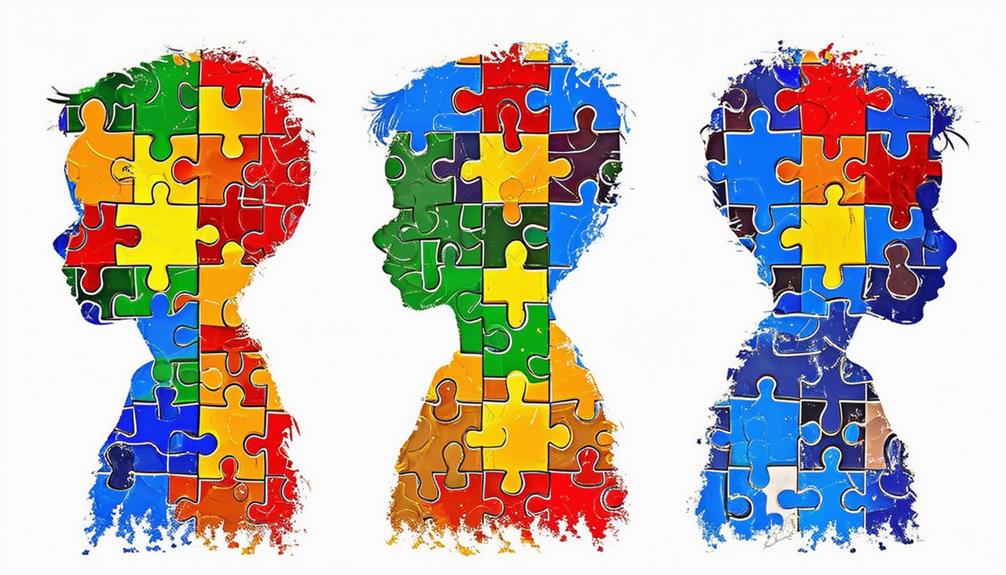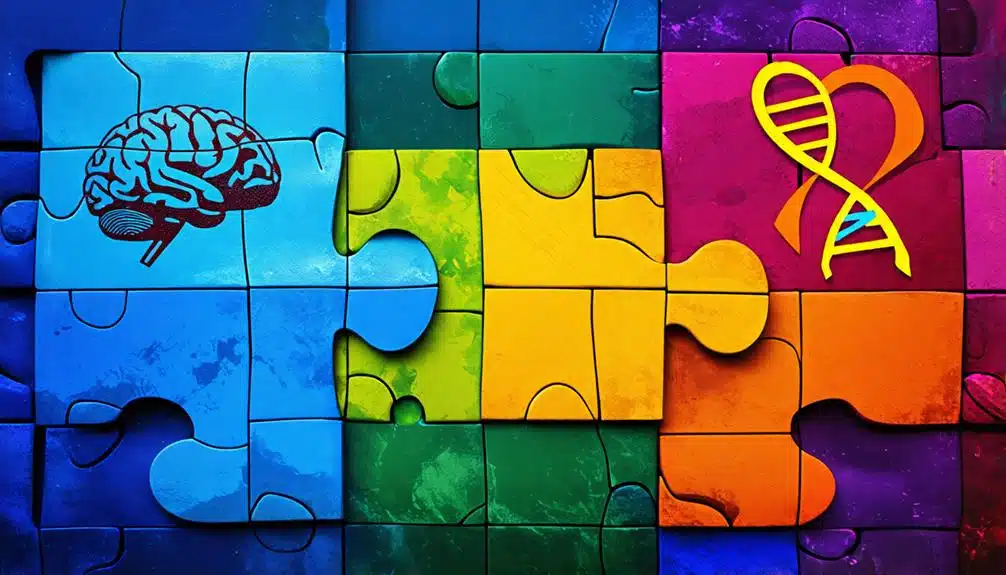As professionals in the field, we must deepen our understanding of the three different levels of Autism Spectrum Disorder (ASD). This knowledge is not just theoretical; it dramatically influences the quality and effectiveness of our Support. As we investigate the distinct challenges and strengths inherent to the different levels of autism – from Level 1, which necessitates Support, to Level 3, requiring extensive Support – we pave the way for more tailored and effective interventions. Let us start on this enlightening journey, enhancing our practice and changing lives.
Key Takeaways
- Autism Spectrum Disorder (ASD) is categorized into three levels: Level 1 requires Support, Level 2 requires substantial Support, and Level 3 requires very substantial Support.
- The challenges faced by individuals with ASD vary across levels, from social anxiety to severe communication difficulties and repetitive behaviors.
- ASD levels can change as individuals develop, with support needs varying across different settings, emphasizing the need for a thorough and ongoing assessment.
- Treatment for ASD should be tailored to the individual, recognizing their strengths and challenges and offering personalized and flexible support services.
Understanding Autism Spectrum Disorder
To fully grasp Autism Spectrum Disorder (ASD), it is essential to understand its three separate levels as categorized by the DSM-5: Level 1 (Requires Support), Level 2 (Requires Substantial Support), and Level 3 (Requires Very Substantial Support). Each represents different degrees of difficulties in communication, socialization, and behavior.
In Level 1 ASD, individuals often struggle with understanding social cues and maintaining back-and-forth conversations. Providing appropriate aid can help them navigate social situations more comfortably.
Level 2 ASD, on the other hand, is characterized by more marked challenges. These individuals display repetitive behaviors and can find routine changes particularly tough to cope with. They require substantial assistance to manage their behaviors and adapt to new circumstances.
At the most severe end of the spectrum, Level 3 ASD individuals face significant challenges. They may be nonverbal, have limited speech, and exhibit extreme behavioral inflexibility. Providing very substantial aid is crucial for improving their quality of life.
Understanding these levels is essential for tailoring interventions and aid services to suit the distinct needs of individuals across the spectrum. When serving them, it is paramount to recognize the nuances of these individuals’ communication abilities, behaviors, and aid needs.
Challenges Across ASD Levels
The challenges faced by persons across the spectrum of Autism Spectrum Disorder (ASD) can significantly vary. At each level, from Level 1 to Level 3, individuals may struggle with different difficulties ranging from social anxiety to severe communication challenges.
To better understand, support, and care for those with ASD, it is essential to acknowledge and explore these particular struggles inherent at each level.
Understanding ASD Behavior
Exploring the complexities of Autism Spectrum Disorder (ASD) behavior involves understanding its unique challenges across the three levels, ranging from social anxiety and task organization in Level 1 to specific interests, repetitive behaviors, and communication difficulties in Levels 2 and 3.
These behaviors, while challenging, are significant aspects of the person’s identity and coping mechanisms.
Level 1 individuals often wrestle with social anxiety, finding shifts between tasks or environments overwhelming. They may also have difficulties organizing tasks, affecting their daily functioning. Long-term masking, or the conscious effort to appear ‘normal,’ can lead to burnout in these people.
Specific interests and repetitive behaviors typically characterize level 2 individuals. These behaviors, also known as ‘stimming,’ serve as self-regulating mechanisms, providing comfort and structure. Moving between activities can be particularly challenging for these individuals, as their specific interests often command their focus.
Level 3 individuals face more severe challenges, with significant communication difficulties and preferring parallel play. Repetitive behaviors are also common, serving as a calming mechanism in an often overwhelming world.
Understanding these behaviors is essential in providing empathetic and practical support for individuals across the autism spectrum.
Navigating Social Challenges
Exploring social challenges presents a specific set of difficulties for individuals at each level of the autism spectrum. Level 1 people grapple with social anxiety and understanding of social cues, often facing hurdles in initiating social interactions. These individuals may find it challenging to engage in back-and-forth conversations, which are fundamental to social relationships.
Level 2 people face particular challenges, including pronounced repetitive behaviors or ‘stimming,’ which may be noticeable to others. Coping with changes in routines can also be overwhelming, leading to increased anxiety and behavioral issues. These individuals may require more structured support to navigate their day-to-day lives.
Level 3 people encounter severe social communication issues, limited speech, and extreme rigidity of behavior. These individuals face the most significant hurdles in initiating and maintaining social interactions, and their inflexibility often poses additional challenges.
Understanding these social challenges across the autism spectrum allows caregivers, educators, and peers to support individuals with autism better. By recognizing these challenges, we can foster environments that accommodate their needs, promote their strengths, and offer a compassionate understanding of their specific experiences.
Variability in ASD Levels

The variability inherent in Autism Spectrum Disorder (ASD) levels presents a nuanced landscape that calls for a more personalized understanding. Labeling and support fall short of accurately reflecting the capacities and distinct experiences of those with ASD.
This underscores the significance of continual assessment, acknowledging the potential for shifts between levels and the limitations of DSM-5 descriptions in capturing the diversity of autistic traits.
ASD Levels: Limitations
Despite the structured categorization, ASD levels, while helpful in determining support needs, may not entirely encapsulate the capabilities or lived experiences of people with autism. The DSM descriptions, as a standard measure, often fail to fully portray the distinct characteristics and abilities of autistic individuals, highlighting the heterogeneity in ASD.
Support needs can significantly vary across different settings, and the ASD level assigned at diagnosis can evolve as individuals grow, learn, and face new challenges. This fluidity stresses the importance of regularly reassessing the person’s capacities and supports. Additionally, personalized support services become essential, given the specific nature of each autistic person.
Understanding the heterogeneity of ASD is vital for effective treatment options and support services. The table below summarizes key points:
| ASD Levels | Key Limitations |
|---|---|
| Diagnostic Labels | It may not fully depict individual capacities |
| Support Needs | Can vary across different settings |
| Assigned Level | It can change as the person develops |
| Individualized Services | Essential due to the distinctiveness of each person |
Assessing Individual Capacities
Building on the understanding of limitations in ASD levels, it becomes evident that a thorough assessment of an individual’s capacities and potential variability in ASD levels is of paramount importance. An individual’s placement within the ASD levels helps determine their support needs but may not fully depict their distinct capacities or experiences. These support needs can fluctuate across different settings, highlighting the need for adaptable, personalized interventions.
The DSM descriptions provide a generalized framework but may not capture the full array of traits in autistic individuals, underscoring the necessity of a thorough assessment to understand individual capacities accurately. This variability, or the heterogeneity of ASD, is critical in determining the type and degree of support.
The complexity and diversity of ASD necessitate a tailored approach to intervention. Personalized support services, sensitive to each person’s capacities and challenges, are integral to optimizing outcomes and enhancing the quality of life for people with ASD.
Transitioning Between Levels
Given the dynamic nature of autism spectrum disorder (ASD), it’s not uncommon for people to move between the three levels outlined by the DSM-5, reflecting the variability in their development, abilities, and support. This shift indicates the diversity of ASD, emphasizing the need for flexible and responsive support services.
| Levels of ASD | Tailoring Treatment |
|---|---|
| Level 1 | Requires assistance that enhances social communication skills |
| Level 2 | Requires significant suppoSupportanage daily life challenges |
| Level 3 | Requires extensive suppoSupportddress severe deficits |
Support needs can differ across various environments, and the designated ASD level can change as individuals progress and encounter obstacles. This underscores the significance of recognizing each person’s strengths and challenges, allowing for customizing effective treatment options.
The levels of ASD offer a broad overview of the impact of autism but may not fully capture an individual’s capabilities. Hence, it is crucial to uphold a person-centered approach, ensuring that the support services offered are personalized and flexible, genuinely meeting the individual’s needs and fostering their development.
Causes and Types of Autism
Autism, an intricate developmental disorder, is believed to be caused by an interplay of genetic mutations, environmental factors, prenatal influences, and advanced parental age. This leads to various manifestations, such as classic autism, Asperger’s syndrome, high-functioning autism, low-functioning autism, exceptional autism, and the broad autism phenotype.
Autism Spectrum Disorder (ASD), as defined in the Diagnostic and Statistical Manual, encompasses these variations and is characterized by three different levels of severity. High-performing autism, for instance, is a form of ASD where individuals can perform exceptionally well in certain areas but struggle in others.
The causes and types of autism are multifaceted, requiring personalized approaches to diagnosis and treatment. The complexity of autism’s origins presents significant challenges, yet it also offers numerous pathways to understanding and serving those affected.
As we dig deeper into the complexities of autism, the importance of individualized care becomes increasingly apparent. Options for treatment are as varied as the individuals seeking them, underscoring the need for empathetic, tailored approaches.
Our continued exploration of ASD’s causes and types propels us toward more effective interventions, ultimately fostering an inclusive society that honors the distinct experiences of all individuals.
ASD Level 1: Requiring Support

Diving into the spectrum of Autism Spectrum Disorder, Level 1, formerly known as Asperger’s syndrome, represents the mildest form of autism. Yet, it still presents distinct challenges that warrant careful consideration and support. Individuals with Level 1 autism can experience notable social communication challenges, including difficulty initiating interactions, understanding social cues, and engaging in back-and-forth conversations. These challenges can lead to observable impairments in interpersonal relationships and everyday functioning.
Despite being the mildest form, the impact of these challenges should not be underestimated as they can interfere significantly with the individuals’ ability to navigate their daily lives effectively. The inflexibility of behavior, a characteristic of this level, can further compound these social communication challenges.
As such, individuals at Level 1 must receive the necessary support from qualified professionals. With the proper understanding, strategies, and interventions, these individuals can enhance their social communication skills, better interpret social cues, and learn more adaptive behaviors.
The support they require is vital for overcoming specific challenges and enabling them to thrive and lead fulfilling lives.
ASD Level 2: Requiring Substantial Support
Moving further along the Autism Spectrum, we encounter Level 2 ASD, which is characterized by more pronounced social communication challenges and repetitive behaviors, necessitating substantial support for the people affected. These folks exhibit significant verbal and nonverbal communication struggles, often showing limited initiation of social interactions and reduced responses to social cues. Their difficulty coping with routine changes further compounds these challenges, making the provision of substantial support critical.
Repetitive behaviors, a hallmark of Level 2 ASD, often manifest as inflexibility of behavior, severely limiting the ability of these individuals to adapt to changes. This behavioral rigidity can lead to abnormal responses to social overtures, exacerbating social communication challenges.
It is essential to understand that individuals at this level require more than support; they need substantial, consistent assistance to navigate their daily lives. This includes helping them manage the complexities of social interaction, cope with changes in routine, and mitigate the impact of their repetitive behaviors.
While the challenges faced by those with Level 2 ASD are significant, with the proper support and understanding, they can lead fulfilling lives.
ASD Level 3: Requiring Very Substantial Support

As we further explore the Autism Spectrum, we encounter Level 3 ASD, an intensification of symptoms where people face severe social communication challenges and may have limited or even mute speech capabilities, necessitating very substantial support.
People classified as Level 3 autism require constant guidance and assistance to navigate their daily routines. They exhibit extreme inflexibility of behavior, with any change in routine potentially causing high levels of distress. This level is characterized by severe social interaction and communication challenges, making understanding and relating to the world around them challenging.
Repetitive behaviors often interfere with daily functioning and pose significant barriers to social integration. The necessity for substantial support becomes evident as these individuals struggle to initiate or respond to social interactions. Their challenges may seem overwhelming, but they can learn to manage these symptoms and lead fulfilling lives with dedicated support. Those who serve this population must be equipped with patience, understanding, and specialized training to provide the needed level of support. Recognizing the needs of individuals with Level 3 autism is a vital step in fostering their ability to engage with their environment and achieve their full potential.
Outdated Autism Diagnoses
As we shift our focus to outdated autism diagnoses, it’s essential to acknowledge the historical context of autism understanding and classification.
For instance, the Diagnostic and Statistical Manual of Mental Disorders, Fourth Edition (DSM-IV) delineated five unique subcategories, such as Asperger’s syndrome and autistic disorder, terminology now superseded by the more encompassing DSM-5 criteria.
This evolution in diagnostic criteria not only highlights our growing understanding of autism as a spectrum but also underscores the impact of these outdated terms on past categorizations and support strategies.
DSM-IV Subcategories
In the past, the DSM-IV delineated five specific subcategories of autism, namely Autistic Disorder, Asperger’s Syndrome, Rett Syndrome, Childhood Disintegrative Disorder (CDD), and Pervasive Developmental Disorder Not Otherwise Specified (PDD-NOS). Each subcategory was distinct in its characterization, providing a detailed framework for diagnosis and treatment.
| DSM-IV Subcategory | Key Characteristics | Current Status in DSM-5 |
|---|---|---|
| Autistic Disorder | Impaired social interaction and communication; repetitive behaviors | Subsumed under Autism Spectrum Disorder |
| Asperger’s Syndrome | Impaired social interactions; everyday language and cognitive development | Subsumed under Autism Spectrum Disorder |
| Rett Syndrome | Normal early development, followed by loss of purposeful hand skills, slowed growth, and intellectual disability. | Removed from the autism spectrum |
Asperger’s Syndrome and Autistic Disorder, despite their distinct features, are now regarded as part of a single spectrum in DSM-5: Autism Spectrum Disorder (ASD). Rett Syndrome and CDD, once classified under autism, have been disassociated from the spectrum in the current DSM-5 criteria. This evolution in diagnostic criteria reflects the dynamic nature of our understanding of autism. It serves as a reflection of the relentless pursuit of knowledge in the field of developmental disorders. For those serving individuals with autism, these changes underscore the need for an informed, empathetic, and nuanced approach.
Evolving Autism Understanding
While the DSM-IV once defined specific subcategories such as Asperger’s syndrome and autistic disorder, the modern understanding of autism has evolved to outdated these classifications, reflecting a more nuanced perception of this complex neurodevelopmental condition. This evolution in diagnostic criteria, now referred to as autism spectrum disorder (ASD) under DSM-5, highlights an advancing comprehension of the diverse presentations of autism.
In this evolving understanding of autism, we no longer view it as separate subtypes. Instead, the spectrum concept encapsulates the wide-ranging characteristics and support needs of the autism community. This shift in perspective is informed by the recognition that individuals with autism demonstrate a continuum of abilities, from those requiring significant support to those who are functioning.
The ‘level’ of ASD assigned to an individual now clearly represents their distinct strengths and challenges rather than pigeonholing them into outdated categories. This progression in understanding serves not only to humanize the condition but also to foster empathy and tailor support strategies, thereby empowering those with ASD to reach their fullest potential. This evolution underscores the importance of a flexible, empathetic approach to autism, acknowledging the diversity inherent within ASD.
Impact of Outdated Terms
Exploring the maze of outdated autism diagnoses, we encounter terms like Asperger’s syndrome and autistic disorder, which have been replaced in the current classification of autism spectrum disorder. This evolution in diagnostic terminology, shifting from the DSM-IV to the DSM-5, has seen the five subcategories of autism coalesce into three levels of ASD.
Rett syndrome and childhood disintegrative disorder, formerly considered part of the autism spectrum, have been excluded in updated diagnostic criteria, reflecting a refined understanding of these conditions.
The shift in terminology is not merely a matter of semantics. It has significant implications for those diagnosed with these conditions, their families, and the professionals who serve them.
Autism Diagnosis Process

How does one arrive at an autism diagnosis? This complex process involves thoroughly assessing an individual’s communication, social interaction, and repetitive behaviors to ascertain the level of support needed. QuaSupportprofessionals such as clinicians, psychologists, and developmental pediatricians detail the evaluation process. This team of experts meticulously observes and evaluates the person’s behaviors and developmental milestones.
In the autism diagnosis, specific tools and methodologies are vital:
- An in-depth communication evaluation is conducted to understand how the person expresses and understands language.
- A social interaction assessment is carried out to examine how the person interacts and relates with others.
- The diagnostic process follows the DSM-5 criteria, which lists the specific characteristics and challenges associated with autism.
The importance of an autism diagnosis lies in its ability to open doors to essential resources and specialized therapies. It provides the foundation for a tailored support system that can significantly improve the quality of life for those on the autism spectrum.
Support and Therapy for Autism
An essential component of managing autism is providing extensive support and therapy, which are meticuloSupportilored to enhance communication, social skills, and independence for people with this condition. The primary focus is alleviating the challenges associated with autism, such as difficulties in social interaction and communication.
Behavioral and educational interventions play a significant role in this process, providing carefully designed strategies to address these issues.
While there are no specific medications for autism, therapeutic interventions prove beneficial in addressing the distinct needs of individuals with autism. These interventions range from physical, occupational, and speech-language therapy to social skills training and cognitive behavioral therapy.
The aim is to equip individuals with the skills to navigate their environment more effectively, improving their quality of life.
Involving family members in these therapeutic processes is also essential. Their understanding and support can significantly enhance the supportiveness of interventions.
Outlook and Individualized Approach

As we shift our focus to the future outlook and the importance of an individualized approach, early assessment must be the cornerstone of determining suitable support and enhancing people’s quality of life.
A tailored approach is not just beneficial but essential. Through this lens, we comprehend each person’s needs and provide the most effective support.
Let’s explore the critical elements of this approach:
- Supported Therapies: These are designed to address each person’s communication challenges. They are not one-size-fits-all but are adjusted to meet each individual’s needs.
- Socialization Support: This aims to enhance interaction skills, foster independence, and improve quality of life.
- Behavior Interventions: These strategies aim to manage problematic behaviors and promote positive ones.
Latest Research on Autism
Delving into the latest research on autism sheds light on intriguing developments, from the exploration of dried fruit consumption‘s potential to reduce the risk of type 2 diabetes to the study of AI tools for predicting Alzheimer’s disease in those with autism. Such studies offer promise in expanding our understanding of the multifaceted levels of autism and their distinct characteristics.
The latest research is also focused on developing effective interventions for adults with autism spectrum disorder. Recognizing that autism in adults often requires different strategies than for children, researchers aim to tailor support services to meet these unique needs. This includes enhancing vocational training and social skills programs that accommodate the distinct challenges autism can present in adult social interaction.
Furthermore, the investigation into specific dietary factors and health outcomes seeks to provide additional support for individuals with autism. This promising avenue of research could potentially offer valuable insights into how lifestyle modifications may help manage autism symptoms and improve quality of life.
The latest research is a testament to the scientific community’s ongoing commitment to better understanding autism and providing empathetic, practical support to those affected.
Frequently Asked Questions
What Are the 3 Supports of Autism?
The third level of autism, requiring very substantial support, is characterized by severe social communication difficulties, posSupporterbalism, and extreme behavioral inflexibility, necessitating intensive assistance for daily functioning and interaction.
What Is Understanding Autism Level 3?
Autism Level 3, requiring very substantial support, is characterized by severe social communication challenges, extreSupportvioral inflexibility, and significant distress during changes. Due to their repetitive behaviors, these people often need substantial assistance for daily functioning.
What Is the Difference Between Level 1 and 2 Autism?
The difference between Level 1 and Level 2 autism primarily lies in the severity of social communication challenges and the extent of repetitive behaviors. Due to more pronounced difficulties, Level 2 requires substantial support.
What Does Level 1 Autism LooSupport
Level 1 autism, formerly Asperger’s syndrome, presents mild challenges in social communication. People may struggle to understand social cues, engage in conversations, and manage changes but can flourish with appropriate support and intervention.


Recent Comments